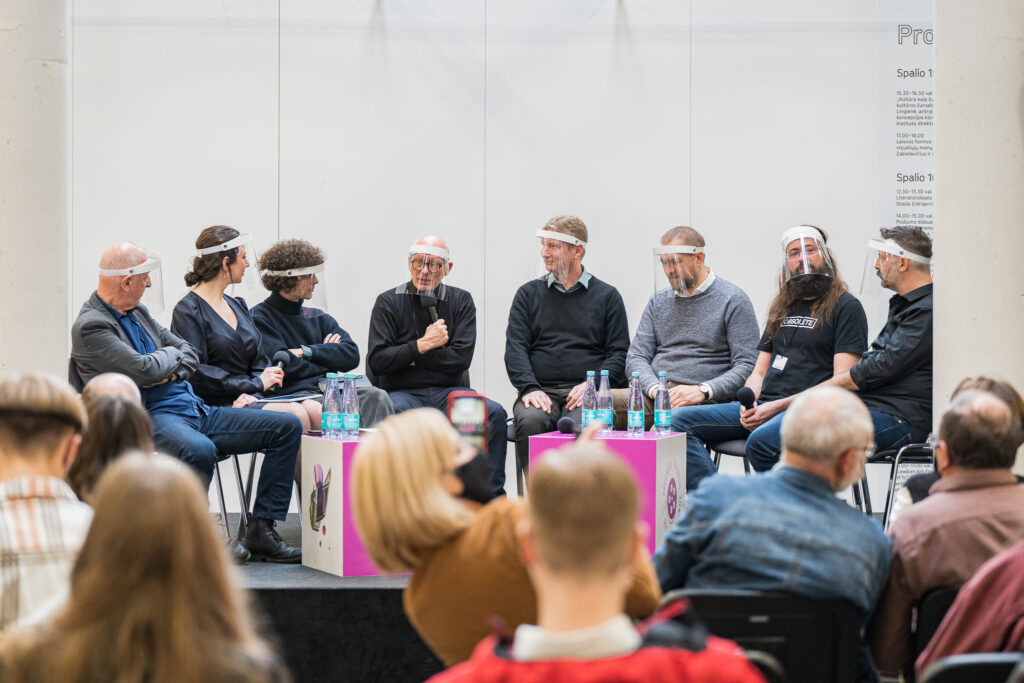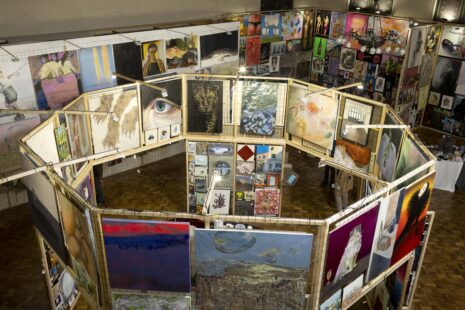The participants of the ArtVilnius’21 Metamodernism conference attempted to answer these questions.
Participants:
- Thorkild NB Nielsen – director of Galleri NB and chairman of the Danish Gallery Association (Denmark);
- Gleb Divov – NFT pioneer, creative technologist, immersive artist, curator, Okapi Galerii, FAYR Ecosystem (Estonia / Lithuania);
- Temuri Khvingija – director, Okapi Galerii, FAYR Ecosystem (Estonia / Lithuania);
- Ian Damerell – artist, philosophy of art lecturer (Norway);
- Vytautas Kašeta – blockchain expert, creator of the Art Tech start-up (Lithuania);
- Reiu TÜÜR – artist, creator of cultural and educational projects, lecturer (Estonia / Lithuania);
- Yves Bartlett – artist (France).
Moderator: Ornela Ramašauskaitė – art market expert, head of the artxchange Global agency (Lithuania).
What changes will be short and long-term in the art market?
Thorkild: Because of what’s going on in the world, most people are struggling and trying to manage the situation. We (gallery) started to find new ways of expressing and showing things (art) through 3D visualizations, extra websites, social media (Instagram and so on).
We’ve started to think about technology like nfts. This might be the future.
How will art galleries change? Do we need them as institutions anymore?
Temuri: I don’t think they will. Nfts are new and yet we still support physical works.
Mr. Reiu, you said to me before the discussion that the changes are not so huge. Could you expand on this?
Reiu: The changes are huge in terms of the world itself. In the art world, there now exist tools to help reach larger audiences. I hope that we will have enough experts in the digital and visual art world who will find new avenues to reach new audiences.
What is your opinion about the use of new technologies in art?
Yves: I think that the question should be, ‘what future do we want?’ I am concerned with ecological issues. If we consider these issues and technology like blockchain, it is nonsense to combine them. I hope the future of art is not going to be NFTs. My friends and I are thinking more and more about the tools we are using in our processes.
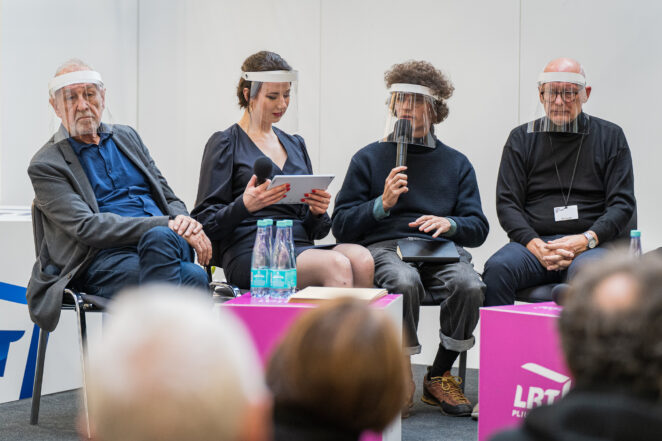
Mr. Gleb, could you please share your experience with nfts?
Gleb: My interest started in 2015. I created musical nfts in 2018 and that was perhaps too early, but now something beautiful is happening. People are interested. But a common issue is when people come and say, “I like your NFT art”. There is no such thing as NFT art. There is digital art and NFT is a blockchain certificate that you can use for a lot of great things. In the future, paying with NFT will start to become increasingly popular – like using a mobile phone for payment. Eventually, it may even be as common as using a credit card to pay. We also use NFT not only for selling digital art but as a key to unlock new possibilities. You can buy NFT and get a physical sculpture, augmented reality, or a vinyl record with an original soundtrack. Also, I need to say that digital art is quite ecological.
Could you share your insights on Covid and what changes it has brought? What is metamodernism and how is it related?
Ian: I would like to talk about post covid times. I doubt that we can go back to how it was before. I can combine Metamodernism with this topic. Very briefly, when we had a modern world we had a belief in rationality, dignity, technological progression. But shortly we realized that, shit, things are not going the way we planned. Slowly we became postmodernists. And it was necessary. Postmodernism was critical and made fun of modernism. But postmodernism became too ironic. People came along and said, ‘Something is wrong. I feel empty. Why am I empty?’ Metamodernism somehow tries to join those two, rather than oppose them. I am into the idea of non-opposition. The French philosopher Jacques Rancière makes it very clear that you can’t oppose. If any you are sceptical of the world you live in you can go and oppose it, but you will be swallowed.
Opposition will only make the thing you oppose stronger. And this applies to art, in that it aims to somehow move slightly away and create a different kind of reality.
It means that every word I say could sound different. The way we talk to each other could be different. Metamodernism is trying to do that and bring mindfulness. To try and stop this, so that in 20 years’ time we may actually have a planet on which we can live.
The other day I met a woman from Ukraine that told me about this guy who, through philosophy and art, tries to educate people. What does it mean to educate? It doesn’t mean I give you something you do not know. It means that, somehow, I know how to start a discussion, that I could learn from you and you from me. It is not opposition; it is another view — another way. Simone Weil once said, “Every being cries out silently to be read differently”.
Could you share your tech point of view and experience?
Vytautas: I wanna share a ground breaking idea with you — we are living in the future NOW! Blockchain technologies have now been here for twenty plus years. Their first real use was in 2009. Now we see other cases of it being used. Everything is now. We had enough nfts in 2015, but not many people knew about them. We can bind anything to the NFT. We can attach physical art. Digital art is as real as physical art and metaverse galleries are as real as physical galleries. What needs to change is peoples’ mindset. We need to discuss creating hybrids. We need hybrid galleries. Physical galleries that showcase digital or AI generated art. Of course, we also need purely metaverse galleries. We need hybrid art pieces. We need physical art pieces related to nfts with the possibility for co-ownership or fractional ownership. The most important thing is to change the mind of the investors. They need the general public to find them and see them.
Are you afraid of the new possibilities of blockchain? How do you see it? As a new possibility or a scam?
Thorkild: No, I am not afraid, just a bit confused because it is totally new. Nfts have raised prices. Art in my home shows my personality. And there are many personalities. I am the only one who buys art in my family. For me, it is important to go home to meet my physical art. Nfts for me are colder and more akin to investments for money. And that is okay, but for me art is the keyword. So we are not frightened.
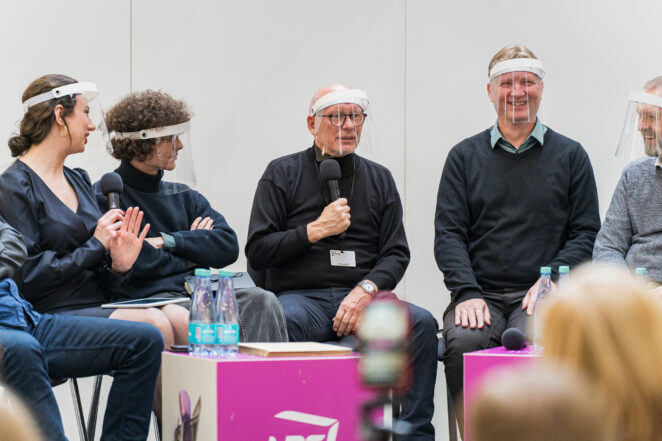
I want to ask about the younger generation as an audience. Do you see a difference in how they perceive art because they are natives to the technological world? Do they seek the same experience as older buyers?
Reiu: I believe that audiences whose age range is out of my box is more aware of climate change, and that is the biggest difference. They like to take selfies next to classical paintings and graphic pieces, and at the same time they are fascinated with video art that is supposed to have changed paintings (replaced them) in post-modern times.
What is modernism? My grandfather was born four years after Les Demoiselles d’Avignon’s painting of cubism and audiences are still in shock and do not accept modernism. So what are you talking about Metamodernism? It is just an escape for the brain. Perhaps it is getting into old brains? The old brains of Mesopotamia, Egypt, or Leonardo da Vinci.
Vytautas: I would like to react to the metaverse part. Nowadays, people tend to attach meta to something and call it new. In some case this is true. We are talking about the metaverse — the new digital universe where we can live. We come home, put glasses on, and we are in the metaverse where we will live our social lives. We need to build 3D homes there and we also want art there. Physical art that is digitalized. I want to own art, not just as a digital picture, but the real thing; the authentic piece. I will buy whatever I can get.
In the digital reality we will need something made out of data.
Gleb: I want to react to Vytautas. It is completely true that the metaverse is currently blooming and digital homes are also in need of art that is unique and original. New generations would like to be owners. I have this certificate that proves that I am an owner. One other thing related to the metaverse — some people do not want to live only in a digital world, so we are popularizing a multiverse, which is going from physical to virtual and back. This creates further possibilities for the expansion of the art.
Ian: I do not see a big difference. I make physical drawings, but that is a system. It is not just putting charcoal on paper. It is the system of meaning; it is a system just the same as what I see on my computer screen. That is also a system. We know it is a system, but we do not understand that drawing is not just drawing, it is also a system.
Why do you need to own art if you can experience art in museums?
Temuri: Because people are different. Maybe because of the story behind a work of art.
Thorkild: Because if you see something special, you want to own it.
Vytautas: I think ownership is about feelings, our social need to own something. This could be competing with someone else to see who can own what. Investors see opportunities to own something that will increase in value. On a social level, it is nice to own a small part of the Mona Lisa or a Rembrandt. Or it is just good to own an art work that you can show to others. It is a social phenomenon.
Temuri: Good point about social needs. Technology goes so fast that no one can feel or touch it. We are social beings, we need to touch, feel, sneeze.
Gleb: New things are coming, e.g. Multiverse galleries. On one hand you will be able to see NFT art in digital galleries in the digital world with the use of special glasses, or you can go to a physical gallery and see NFT art on a screen.
It can seem that there are already too many people and items in this world. By extension, there are a lot of artworks in museum, so maybe the best solution is to stop creating new ones or to switch from physical paintings to digital art? What is your opinion on that?
Yves: That is a sad idea. There is still more art to create, feelings to express. I do not think it is a good question to ask as a collector, artist, or creator. The experience of art can be felt through the screen or a painting. There is, however, a difference between a screen and a painting. During covid there were a lot of digital exhibitions and they weren’t very popular. But after covid people were happy to see live artworks and meet the artists.
The question we should ask ourselves is, ‘what experience do we want from artworks?’
Gleb: It shouldn’t be one or the other but both. Consider the invention of photography and how at first it was not considered an art form. So, it is not a question about switching from one form to the other but about striking the right balance.
What other changes do you foresee in the art market?
Ian: I want to carry on where you left off (shows at Gleb) with changes. There are other changes that will affect the art market. [He carries on telling a story about the art piece “Fountain”, a urinal placed on exhibit by Marcel Duchamp, a pioneer of dadaism, in 1917.]
Duchamp changed art completely. It is interesting when we discuss what constitutes ‘real art’ (refer to the discussion about digital and physical art). I don’t see the difference and of course there is difference (refers to the difference between mediums). And the question ‘will you accept this as art?’ still applies in this situation. [He carries on to tell a story about Beedbed – a performance by Vito Acconci where he lays beneath a ramp built in the Sonnabend Gallery. Over the course of three weeks, he masturbated eight hours a day.] I think it is disgusting. To conclude, what exactly are we talking about when we talk about ‘art’?
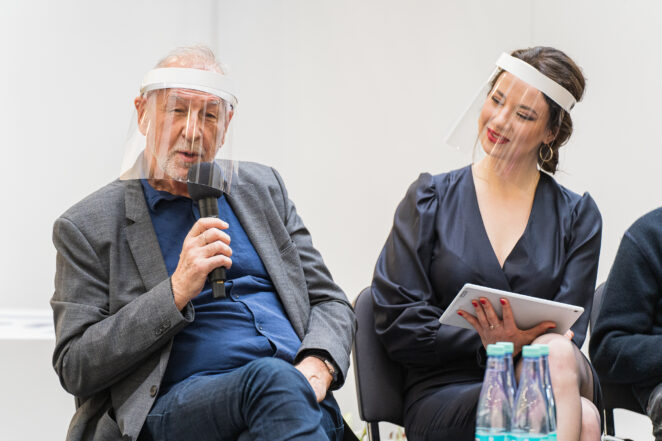
Speaking about changes in the art market, do you see changes in artists and their styles?
Thorkild: Artists are always changing, but they are still personalities and they do not change their personalities. Maybe they use different materials instead: a brush, fingers, or computers. For me it is important to understand what expression is most important for the audience. We have some nice art created in virtual reality, but the problem is that it has a very limited audience. Some artists become inspired to create digital art, but there are not many at the moment. The Younger generation is more used to using tools to create digital art and it is going to develop very fast and in many ways. Just look at how we are talking about NFTs now.
Gleb: As an artist I prefer to create not only digital art but also to take a brush and do something, or take pencil, or experiment with AI. There are a lot of possibilities, and it is up to the artist what they use. It is not about change but about personal development.
Vytautas: We can talk about AI generated art, which is usually computer-generated art, crypto ART, NFTs, they are still just the techniques, because somebody has to think about the idea, the composition, and even start with some elements. What the computer generates is only created from these elements. And usually those people, despite being programmers, are also artists. It is a lot Iike photography. Make one piece and you can produce more.
Gleb: There is not only AI generated art but also a new way to create when you work with AI in partnership. In this case, it is not that you say to the computer ‘push this button’, but it is more about the research and collaboration of the data, topic, and subject. And this way of collaboration (human-computer) can exert influence on art and art market.
Thorkild: I think that with digital art – the same as with sculpture and brushes and so on – 80% of technically well skilled people can make it, but just 20% have actual talent.
Reiu: One of my professors said that there is no art market without art experts. The more Madonnas you have in your market place, the better it is for the market. Not many people have that talent. The minority have developed talents in that direction, to celebrate the visual.
For me the ideal outcome would be if the fisherman could fish out the bits of Rembrandt and other pieces from the art market.
What do you find missing or lacking in the galleries you work with?
Yves: To me what seemed important is the social condition of the artists. In France we fight with art centres and galleries, imploring them to pay artists who exhibit their art there. To consider artworks as the real work. And now in France there is the real issue of promoting the idea of paying artists for showing their works. I hope the concept of respecting artists for being artists will evolve in the future.
What is your opinion on the future? What are some utopian and dystopian scenarios for the future of the art market?
Ian: What I have been trying to explain is that I don’t see the changes from physical art to virtual art as being so great. So, I am not sure how to answer that. And I do not like the word utopia. Some guy from Austria went to Germany to discuss the idea of utopia in 1930 and that didn’t go so well. You have also experienced ‘utopia’ here in Lithuania and it didn’t work out either. I don’t like the idea of utopia at all. The art is a system, just like how I am speaking now. I am speaking a language, which isn’t mine by the way, but we understand each other. It is a system. Of course, if art meets another system it might fail. I used to work at the Goldsmith college of art, which was quite popular when I was there. There was a guy who worked there, a very interesting American. He made a work of art named “Oak Tree”, and it was a glass of water. He put that glass up on the wall with an explanation as to why this glass of water was an “Oak Tree”. It became kinda famous. It was sent to Australia for exhibition. At the customs office they said that they wouldn’t allow any kind of tree to enter into Australia. So the artist said… ‘it is a glass of water’. It says a lot. He tried to move from one system to enter another.
Gleb: Just to add to the bit about utopia in Lithuania. We have a great example of the Republic of Užupis (art district in Vilnius – red.) That existed for 20 years and bloomed.
Could you please share what you have taken from this discussion and what would you like to leave the audience with?
Temuri: Gleb threw me into this computerizing digital art and nfts world, and now I am floating. I really need to understand how this particular NFT stuff can be more harmful than computerizing at all? Silicon Valley has thousands of racks of gbs/kilobits using energy. I want to know how it is more harmful then producing an art installation comprised of many materials, which sometimes, after the project is done, are thrown away.
Gleb: For me it was interesting to see many different points of view. And what we started back then is still going slow (nfts) and it will find some truth in life. When we organized the first Lithuanian NFT exhibition in 2019, I tried to talk with people about NFT and most of the people said, “oh no”. Today I am talking to the same people, and they still do not understand it, but I see a change in the mindset. Maybe it is due to two years of lockdown, because the whole world went more digital, but in reality it is more about global changes. It is nice to see changes in peoples’ mindsets globally, and we are ready to go further.
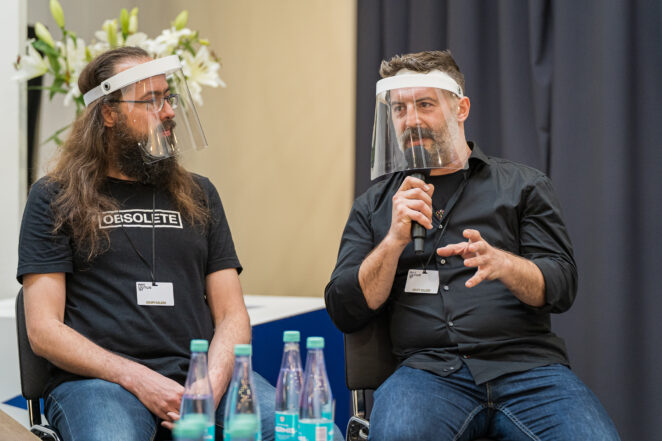
Vytautas: What I heard here is that everything we talked about will stay and will find its way, its niche. And on both sides we need be open to new things. Six or so months ago nobody was talking about nfts except for technical people and some open-minded people from the industry. Now it is more well known. We should be open to everything. It can be a huge pile of money, social needs, or good feelings. On the other hand, we are moving towards hybridisation – not purely digital or purely physical. Some hybrids exist in both universes, in the multiverse, metaverse, all over. And this thing is going to stay. We are changing.
Reiu: I just think about the future, and I see some parts of the future are already here now. I would like to know what will happen to gallerists; will we stay the same?
Is digitalization taking galleries into the clouds or into the cage?
Thorkild: I do not talk about changes because I do not think anything changes. I think there are more possibilities, maybe that is what changed. It hasn’t always been like this. The problem is that all the possibilities increase and now the number of possibilities is huge. And now for you (people) it is a problem to even think about it. In what way will you need a gallery to take care of these issues? Every gallery is a personality. We are not a branch, we are individuals. Some like one thing, another likes another thing, and there comes a new generation of gallerists that will take these new ideas. But in five years’ time we will all be talking about something new.
Yves: For me the future is art. The future is ecological. The future is feminism.
Ian: As mentioned before, we are living in a very unfair world. I came from a country where 15% of people are starving. That’s Britain. So, I believe that art should somehow activate people and not just how it used to. It doesn’t work. You cannot oppose the system that creates such an unfair world. You have to go somewhere else. Do something else, speak differently, so that the words you say are different, so that the people who hear them will understand differently. It is not about trends or all of these other things. These things do not matter. I exhibited two years ago in the contemporary art centre and was asked to come on a weekend to talk to the people. Not to curators, not to gallery owners. I wouldn’t get anything out of it. 50 people came and I did it. We were 40 artists and only one other artist did it too. I am not blaming them, it is not their fault, it is a sign of the times, because you do not have the time for it. Haven’t you heard, these millionaire videos on Tik Tok telling you what to do. God, you sleep 8 hours? Shame on you! You should be working hard. Rubbish.
I will finish by mentioning again how important it was for me that this Ukrainian person told me about this guy who started to educate. And I told you what I mean by educating. I mean not telling other people what to do but orchestrating in some way. This is how art should work. Even if the artist may be the greatest snob on Earth who wants to make money, it could be that his art actually talks in a different way. That is what’s fascinating about art. Art is separate from the artist and the art world, even though the art world tells you what art is. Still, art has this element in my mind. And that is from my favourite philosopher, Schopenhauer, “Art alone can change the world”. That is what I mean by that, not the artists but art. Some artists too, of course. And I will finish with this one, “Talk about what nobody else has not talked about”.

Photos: Andrej Vasilenko

